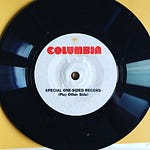Every so often, someone on Twitter posts the video for Alien Ant Farm’s cover of Michael Jackson’s “Smooth Criminal” and it goes somewhat viral.
The comments tend to focus on the year the video dropped—2001. People marvel at how different times were 21 years ago, on the edge of the previous millennium.
I think this is why the video spreads. If it were the song alone, then we’d likely see it ranked higher on streaming services. Instead, the clip catches on in places where people can collectively comment on it. And there’s a lot to comment on. The video offers the type of limited view of the past that nostalgia is made of. The barrage of early 2000s cliches and of-their-time ideas never feels familiar to a modern eye. There’s the nu-metalish sound, the baggy pants, the no longer familiar haircuts. The guitar player wears a short-sleeved collared shirt under a t-shirt. The bass player has the era’s requisite extra strings, which allow for lower notes but make his instrument’s neck look like the removable leaf from a dining table. These dated elements, plus the fact that the video is three-and-a-half minutes of kids goofing off to a cover nobody asked for, makes the turn of the last century seem like a time when anything was possible. It was an era when it was fashionable to wear big ski goggles as a headband, after all.
“It’s so cliché to say simpler times, but it was,” singer Dryden Mitchell told the Los Angeles Times this year. “Everything was clicking. We were like the last of those platinum bands, you know what I mean?”
Mitchell is not exaggerating when he says platinum, and this, too, makes the era seem fictitiously distant. Alien Ant Farm sold over a million copies of the album with “Smooth Criminal” on it. The track was the top rock song in America for a period of time. And it was number 23 on the Hot 100. But in 1999, moving a million CDs (priced $15 to $20 each) was barely enough to register as more than a flash-in-the-pan for a rock band. Offspring sold five times as many copies of their album Americana. Even that was modest compared to the sales for pop and hip-hop. The “Smooth Criminal” video is a scene of a party that was just about to end.
The clip looks old to me, but old in a familiar way. I was 15 when it went into regular rotation on MTV. At the time, the original “Smooth Criminal” seemed much older. Part of this was due to the fact that Bad was one of the best-selling records of all time and every single from it was ubiquitous. There’s also the narcissistic tendency of youth to write off anything a previous generation liked as impossible ancient. On top of all this, teenagers burn through music and phases, and I had already seen several evolutions of pop, rock, r&b, and rap, not to mention many news cycles about Jackson himself.
However, “Smooth Criminal” came out in 1987. The period between today and Alien Ant Farm’s cover is fifty percent longer than the period between that cover and the original. It doesn’t feel that way. Sure, time moves faster when you’re young. The gap between ages two and 15 feels much longer than the one between ages 15 and 37. But to compare the two songs and the time between them invites the kind of contemplation about aging and cultural progress that this newsletter celebrates. Let’s get into it.
This is another one of the math games that I like to play with pop culture. Last time I did this, I pointed out that as much time has passed between now and TLC’s “Waterfalls” as passed between Back to the Future and “Johnny B. Goode.” This time, I want to look at covers.
As far as I can find, the 72-year gap between Scott Joplin writing “The Entertainer” and Marvin Hamlisch charting with a recording of it in the 1970s is the longest stretch between a song’s composition and its appearance on the chart. But Hamlisch’s recording isn’t really a cover, since Joplin wrote the original in a time when songs were sold as sheet music, not records. For my purposes here, I’m interested in songs that one artist recorded and released, and another artist re-recorded. What is the longest stretch between a song’s original release and its appearance on the charts under another artist’s name?
It’s certainly not 14 years. But when I thought of other popular covers from my youth, the time between them and the original was surprisingly short. For example, Johnny Cash’s cover of “Hurt” came out just seven years after the Nine Inch Nails original.
Like with any of these little math games, looking for the answer is more fun than finding it. Here are a few of the distances I calculated on my journey:
The time between…
The Chicks’ cover of Fleetwood Mac’s “Landslide”: 27 years (1975-2002)
Whitney Houston’s cover of Dolly Parton’s “I Will Always Love You”: 18 years (1974-1992)
Lil Kim, Pink, Mya, and Christina Aguilera’s cover of Labelle’s “Lady Marmalade”: 26 years (1975-2001)
Club Nouveau’s cover of Bill Withers’s “Lean on Me”: 15 years (1972-1987)
The Fugees’ cover of Roberta Flack’s “Killing Me Softly”: 23 years (1973-1996)
Jimi Hendrix’s cover of Bob Dylan’s “All Along the Watchtower”: One year (1967-1968)
Joe Cocker’s cover of the Beatles’ “With a Little Help from My Friends”: One year (1967-1968)
Earth, Wind & Fire’s cover of the Beatles’ “Got to Get You into My Life”: 12 years (1966-1978)
Ike and Tina Turner’s cover of Creedence Clearwater Revival’s “Proud Mary”: Two years (1969-1971)
John Cale’s cover of Leonard Cohen’s “Hallelujah”: Seven years (1984-1991)
Jeff Buckley’s cover of John Cale’s cover of Leonard Cohen’s “Hallelujah”: Three years (1991-1994)
Rufus Wainwright’s Shrek soundtrack cover of Jeff Buckley’s cover of John Cale’s cover of Leonard Cohen’s “Hallelujah”: Seven years (1994-2001)
The most surprising thing about this list is how much movie soundtracks can propel a hit. “I Will Always Love You” was on the soundtrack for The Bodyguard. And before that, Parton’s version returned to the charts in 1982 after it was included in Best Little Whorehouse in Texas. As much as musicians may herald “Hallelujah” as a masterpiece, it owes most of its modern ubiquity to Shrek, which not only introduced the song to a new audience, but also delivered the most accessible cover of the track to date.1 The soundtrack is sometimes the cause for the cover, like with Earth, Wind & Fire recording “Got to Get You into My Life” for the Sgt. Pepper movie. And of course, Hamlisch’s “The Entertainer” was on the soundtrack to The Sting. I suspect this is because movies reach a different audience than music—often one that’s older and less likely to listen to new pop music. In the era before streaming music, soundtracks were also a popular and profitable way to sell a collection of songs that already existed—basically like charging $20 for a mixtape.
A movie soundtrack is responsible for the two widest gaps between cover and original that I can find. The first is Madonna’s cover of Don McLean’s “American Pie.” There’s a 29-year gap between McLean’s original in 1971 and Madonna’s version on the soundtrack of the 2000 movie The Next Best Thing. The cover was popular, even though it was never a single in the U.S. But the longest gap I can find is just a few years wider than this. Unlike the other, though, it’s not a case of a soundtrack pushing a cover—it’s a cover of a song meant for a movie. In 1993, UB40 had a hit with “Can’t Help Falling in Love,” which Elvis recorded 32 years earlier for the 1961 movie Blue Hawaii.
If a song isn’t driven by a movie, then there’s a genre change or an element of rediscovery—the coverer plucks a song from another scene or a less-famous artist.
None of this speaks to a science of the perfect cover. But they do speak to a history. There aren’t that many big popular covers now. The most popular recent cover I can find is a nu-metal remake of Simon and Garfunkel’s “The Sound of Silence” by Disturbed, released more than 40 years after the original. But it was a hit on the modern rock charts, a list that has almost no relation to the Billboard Hot 100.
Occasionally there may be a live cover or a celebrity duet, a la Harry Styles bringing Shania Twain on stage. These treat the cover as a novelty. The artistry that once went into covers now lies in sampling, remixing, and interpolating, often using tools that go beyond the guitar, voice, and drums to make something new out of source material that goes beyond a single song.
This makes that Alien Ant Farm video seem all the more ancient. Covers now are Coachella stunts and YouTube video events. To see a group of people just play someone else’s song for four minutes, in a video that was clearly costly to produce, is to see an artifact of a time that no longer exists. It was 21 years ago, but it may as well be 50…or 500.
Wainwright’s cover is only on the soundtrack album. John Cale’s version is in the movie. While I have your attention in this footnote about the Shrek soundtrack, let me also point out how it made a hit of the Smash Mouth song “All Star,” even though “All Star” was written for a different movie—1999’s Mystery Men.
















Share this post